Communications within an organization serve at least two inseparable purposes. On one hand, without comfortable interaction, it is impossible to create a harmonious internal team environment. On the other hand, without exchanging information about work processes, tasks simply won’t align. Therefore, it is crucial to carefully consider various types and means of communication within companies.

What is the communicative process?
Communication plays an invaluable role in the operation of any enterprise. Communication within an organization is a mandatory condition for various aspects of work, including:
- Goal and Task Setting: Enables employees to understand expectations and work harmoniously to achieve common objectives.
- Exchange of Information and Ideas: Facilitates making informed and effective decisions.
- Task Implementation, Coordination of Actions, Problem-Solving: Achieving results through the process of communication.
- Open and Honest Communication: Motivates employees, creating an atmosphere of trust and support.
- Building Strong Relationships and a Sense of a Unified Team: Communication in the organization helps foster strong relationships and a sense of a cohesive team.
To ensure that all communication functions are fulfilled, the communication structure must be well-coordinated, free of obstacles, and include all necessary components.
Communication Structure
The transactional model of communication is the most logical, consisting of sequential stages:

This is simple yet effective model succinctly describes the components of the communication process:
- Sender: The individual or group generating an idea or information and transmitting it. The sender must formulate their thoughts and choose an appropriate channel for transmission.
- Communication Channel: The means through which the message is sent. It can be verbal (oral, written language) or non-verbal (gestures, reports, sketches). The channel should be relevant to the target audience and the content of the message.
- Message: The information transmitted from the sender to the receiver. Messages can include news, tasks, orders, questions, etc., but it is crucial for them to be understandable to the receiver.
- Recipient: The person or group receiving the message. Similar to the sender, the recipient can be an individual or a group. The recipient must receive and correctly understand the message.
In addition to these fundamental elements, the information exchange process may involve additional factors:
- Feedback: The receiver’s response to clarify or confirm their understanding of the message.
- Barriers: Any obstacles that may distort the message (e.g., noise in the room, lack of communication, or errors in data transmission).
Communication Barriers
Communication barriers in a company are obstacles that hinder effective exchange of information and ideas. Anything can be a barrier, ranging from objective to purely subjective reasons.
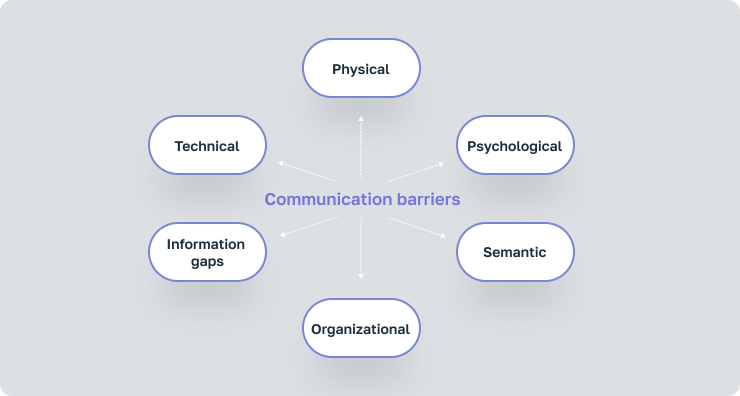
Let’s discuss some common reasons complicating communication within an organization:
- Physical Barriers: Such as noise, poor visibility, or significant distances.
- Psychological Barriers: Such as fear of management, uncertainty in decision-making, or misunderstandings due to different experiences.
- Semantic Barriers: Including differences in terminology, misleading formulations, or the use of slang.
- Organizational Barriers: Complex hierarchies impeding communication, bureaucratic processes complicating interaction.
- Information Gaps: If team members lack necessary information for effective exchange.
- Technical Barriers: Absence or inconvenience of communication tools within the organization.
To overcome or avoid creating barriers in workplace communication, it is necessary to foster an atmosphere of trust and openness within the team and utilize appropriate communication types.
Types of Communication in Organizations
The types of communication based on the relationships between participants are prerequisites for effective message exchange without unnecessary obstacles.
Different types of communication may be used in one company depending on the number of employees, team composition, ongoing projects, and other circumstances. Each type of communication plays its crucial role in organizational communication. Therefore, understanding various communication types and their characteristics is beneficial.
Vertical Communication
Communication between management and subordinates. Can flow both top-down (e.g., task assignments) and bottom-up (e.g., reports from subordinates to management).
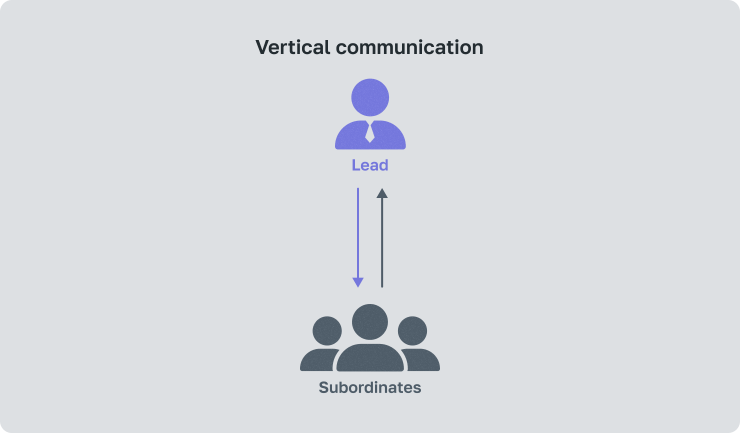
Horizontal Communication
Communication between colleagues on the same level. Essential for collaboration, coordination of actions, and synchronization of work processes between different teams.
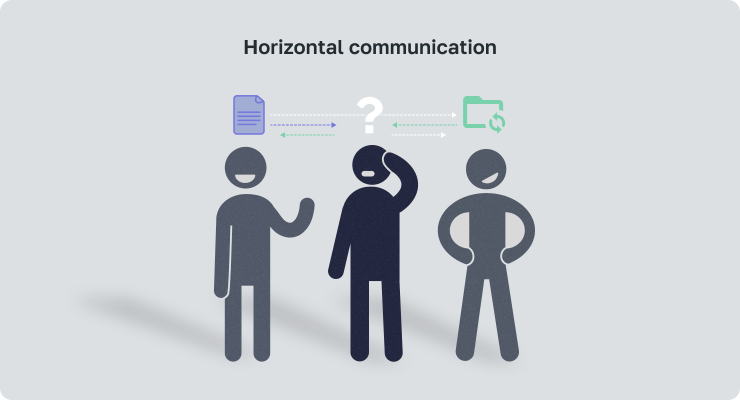
External Communication
Communication with clients, partners, investors, and other external stakeholders.

Diagonal Communication
Communication where employees from different departments and hierarchy levels can communicate directly without involving managers or other “intermediary” links.
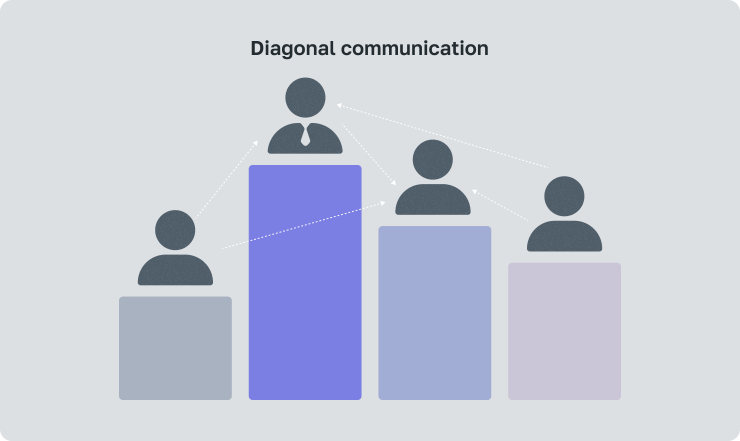
Well-selected, configured, and applied types of communication in a company enhance the speed and efficiency of information exchange, improve connections between different departments and employee engagement levels. They also contribute to innovation and overall company development.
However, errors in communication settings can lead to “information noise” and information overload, creating confusion and ambiguity. To avoid such complications and achieve communication efficiency, it is necessary to:
- Establish rules and communication procedures in the company.
- Train employees.
- Provide the necessary infrastructure for communication tools.
Means of Communication Within a Company
Communication tools in an organization can be conventionally divided into two categories:
Synchronous
- Instant Messaging (WhatsApp, Telegram, Facebook Messenger, etc.).
- Phone Calls (mobile, landline).
- Video Calls (visual contact as an advantage).
- Web Conferences (provide shared access to screens, presentations, chat, and other functions).
- Meetings and Conferences (various numbers of people can meet in person or online).
Asynchronous
- Email (text messages, files, and other information stored until deleted).
- Project Management Systems (aid in planning, organizing, and tracking tasks and goals).
- Internal Forums (communication and information exchange strictly within the organization).
- Social Networks (can be used for personal and business communication).
- Surveys (data collection for research, feedback, etc.).
Chatbots and notification systems can belong to both categories of communication tools. All of them can be used in various combinations for the convenience of teams. The diversity of communication tools in an organization promotes efficient information exchange. However, in practice, some communication tools are more prevalent than others, such as messengers and work calls.
Messengers in Workplace Communication
Most companies use messengers for communication among colleagues. It is indeed a convenient and familiar means of communication that has seamlessly integrated into everyday life. However, it’s essential to consider that messengers were not specifically designed for work communication, so their use has both advantages and disadvantages.

Advantages of Messengers in Team Communication:
- Mobility: Messengers are available on mobile devices, allowing employees to stay connected anytime, anywhere.
- Operational: The ability to send and receive messages and responses in real-time.
- Simplicity: Messengers are user-friendly, familiar to all employees, and do not require special training.
- Team Collaboration: Group chats can be created for communication within the entire team or specific departments.
- Materials: The ability to send files in various formats, exchange documents, images, media.
Disadvantages of Messengers:
- Unstructured Data: Information in messengers arrives and is stored chronologically, making it challenging to search and utilize.
- Lack of Context and Details: Messengers can be inconvenient for tracking task progress due to the absence of context.
- Information Overload: Employees may receive too many work and personal messages across different messengers, diverting attention and consuming time.
- Security: Most messengers do not provide a sufficient level of security, making them unsuitable for discussing confidential matters.
Using messengers for work communication is possible, taking into account their pros and cons. It’s crucial to clearly define rules for using messengers in the company, train employees, and ensure the necessary communication tools infrastructure.
Work Calls: Pros and Cons
Work calls are traditionally a popular tool for work communication, and they have certain advantages and disadvantages.

Advantages of Work Calls:
- Personal Interaction: The voice and intonation of the interlocutor make communication more meaningful.
- Promptness: The ability to quickly get answers to questions or immediately clarify details.
- Involvement of Multiple Participants: In group discussions via video calls.
Disadvantages of Work Calls:
- Time Consumption: Calls can take up a significant amount of time, especially with many participants.
- Data Fixation: Information discussed over the phone or through video calls is harder to document and apply in work.
- Technical Issues: Calls may be interrupted due to communication glitches.
- Distraction: Calls demand full attention, making it impossible to multitask, such as during email correspondence.
If a workday is overloaded with calls, work efficiency decreases, and individuals can quickly become fatigued from the volume of contacts and information. Therefore, it’s advisable to use work communication selectively, only when truly appropriate.
When is Communication through Work Calls Appropriate?
Calls bring the most benefit to team communication when used in moderation and when truly needed:
- Urgent Matters: For discussing urgent issues in real-time.
- Complex Problem-Solving: To address intricate problems requiring simultaneous involvement of team members.
- Personal Interaction: Between managers, HR, and employees.
- Scheduled Online Team Meetings: For regular planned team or department meetings.
To avoid overloading schedules with calls, clearly define their content and purpose, communicate concisely, and adhere to timing. Following these simple communication rules can make interactions within the company effective and meaningful.
Why is Meaningful Communication Important?
Meaningful communication is consciously directed communication aimed at achieving a specific goal. The meaningfulness of communication can be determined by:
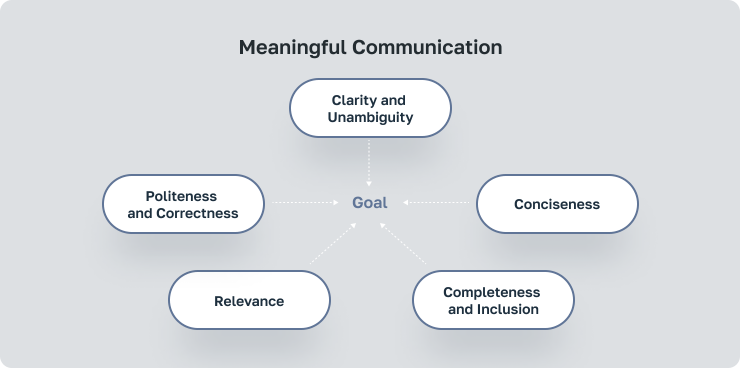
- Clarity and Unambiguity of Messages.
- Conciseness.
- Completeness and Inclusion of All Necessary Information.
- Relevance to the Conversation Topic.
- Politeness and Correctness.
The importance of meaningful communication cannot be overstated for several reasons:
- Improves Work Efficiency: Clear and concise communication enables people to perform their tasks faster and better.
- Enhances Relationships: Meaningful communication contributes to understanding among individuals and team building.
- Facilitates Innovation: Increased sharing of ideas and information leads to the generation of new ideas and solutions.
- Reduces Error Risks: Clear communication helps avoid misunderstandings and errors.
- Increases Job Satisfaction: People are more satisfied with their work when they feel heard and understood.
However, all these advantages can be neutralized by several factors that hinder meaningful communication.
What prevents companies from building meaningful communication
The exchange of information in the organization will not be meaningful if there are one or more obstacles:
- Lack of openness and trust culture. If employees don’t feel comfortable talking about their ideas and problems, effective communication is impossible.
- Unclear communication: If management does not set clear goals and objectives, employees will not know what is expected of them.
- Bureaucracy. Complex procedures and strict formalities hinder effective and meaningful communication.
- Technological disadvantages. Useful tools are necessary for meaningful communication.
Improving Communication in the Organization
The communication process is a flexible and adaptive information exchange system that can and should be improved. To build quality and meaningful communication, companies should, at a minimum: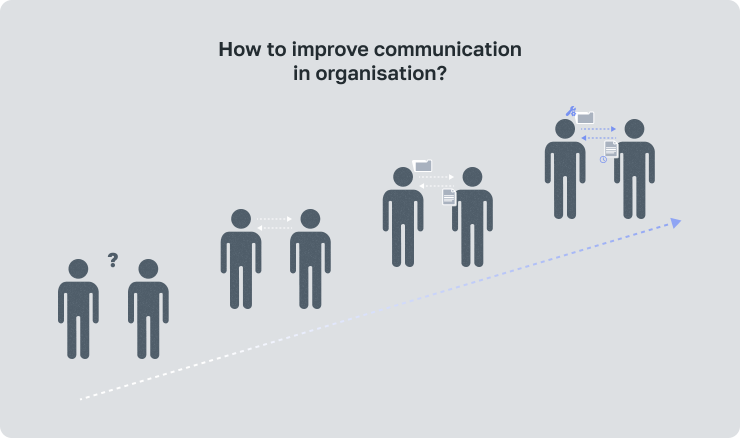
- Create a Culture of Openness and Trust: Establish practices for information exchange in the work process.
- Ensure Clear Communication Standards: Specify task formats and response times.
- Develop Effective Communication Skills: Train both leaders and subordinates.
- Provide Convenient Communication Tools for Employees.
Communications meeting these conditions benefit both business processes and the team atmosphere. However, continual monitoring of communication quality and regular reviews of communication tools’ relevance in your company are essential.
Transition to More Informative Messaging
Communication tools in the organization are constantly being improved in response to the needs of users. Therefore, both traditional and innovative communication tools are currently available, among which each team chooses the most convenient combination of communication tools. These include:
- Messengers
- Phone Calls
- Video Conferences
- Internal Forums and Chats
- Notification Systems
- Internet Platforms
- Surveys
- Project Management Systems
The choice of specific tools and their quantity depends on the company’s size, its projects, and the components of effective communication suitable for your team.
Worksection: A Tool for Structured and Effective Communication
Worksection is a project and team management system. Apart from efficient control and reporting tools, Worksection offers integrated communication features, making it operational, convenient, and effective.
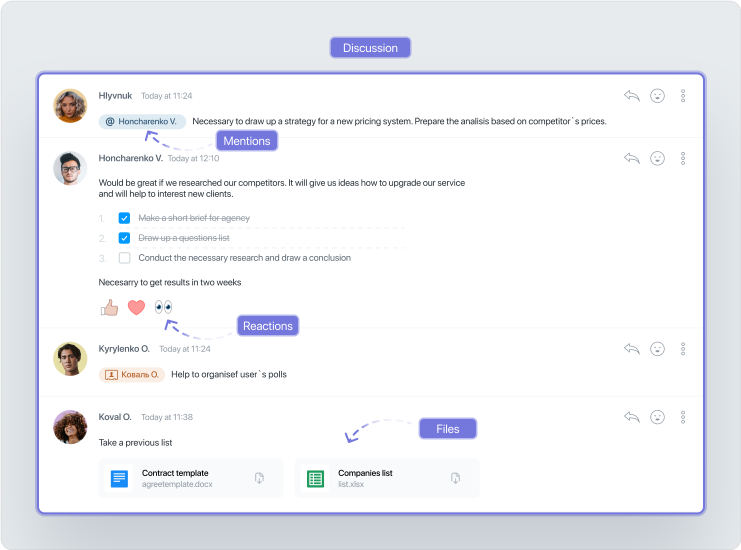
Worksection helps your team organize all work within one system. Messages and files are stored directly in tasks, making it the most meaningful and fastest way to exchange information, communicate with colleagues and clients, share files, discuss, and provide feedback.
Using Worksection for Building Effective Communication
Communication in Worksection is linked to specific tasks. Team members can utilize various features for meaningful information and data exchange:
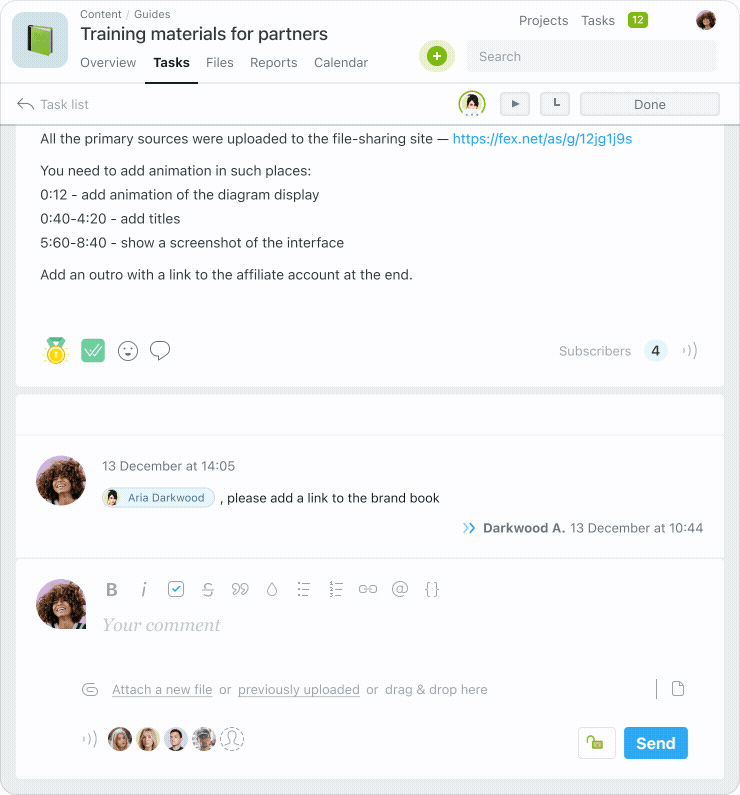
- Instant Notifications of Task Updates: New comments are displayed immediately without refreshing the recipient’s page.
- Personalized Settings for Receiving Emails, Online Messages, and Push Notifications.
- File Work allows viewing graphics, editing Google Docs, and creating new documents of docx, xlsx, and pptx types available for collaboration.
- Employee Contact Details can be used as a contact base with quick search.
- Integration with Telegram, Viber, Messenger according to employees’ preferences.
All these Worksection features contribute to meaningful communication within the organization, both within individual tasks and across the entire platform’s notification system.
Conclusions
Effective communication helps companies achieve their goals and maintain a positive and productive work atmosphere. To achieve this, it’s essential to establish a convenient communication system within the organization and have efficient tools for its implementation.
Among numerous communication tools, choosing one integrated into the team’s work management system is optimal. This saves time and ensures synchronization of all business processes without data loss. Therefore, Worksection is an ideal solution for both project management and team communication.
